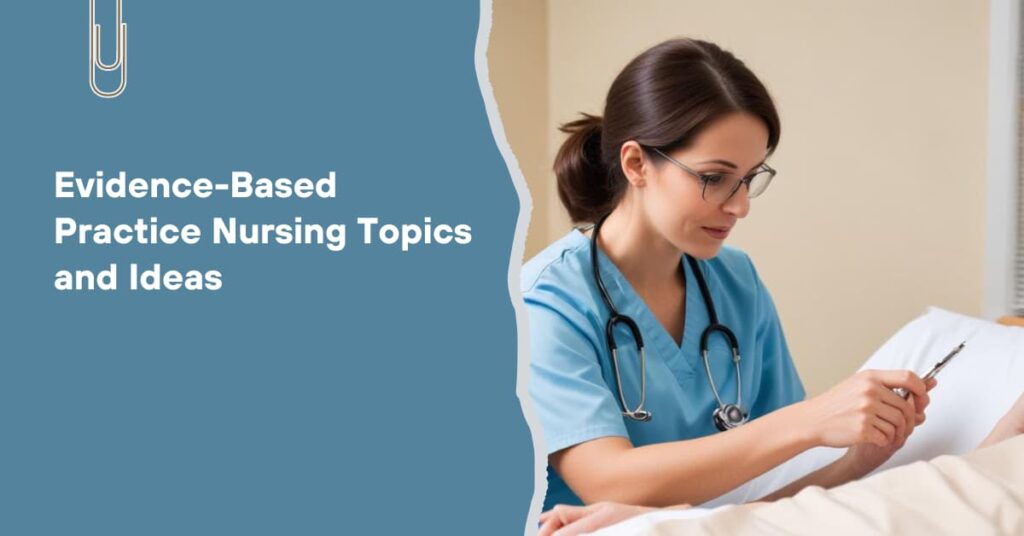Are you a nurse who wants to enhance satisfaction with patients, improve patient outcomes, and make what you do better? Do you balance traditional methods of nursing with fresh concepts on patients’ safety in the health care? Evidence-based medicine (EBP) in healthcare utilizes current research and clinical data to direct treatments. This method ensures that Nursing tasks are founded on reliable evidence which improves her outcome. Looking for what evidence-based practice in nursing is all about? Read this article that describes it and provides several practical examples of how to implement EBP well.
In nursing, what is evidence-based practice?
Table of Contents
ToggleEvidence-based nurse practice is a way of patient care that brings careful consideration with patient values and preferences. In this way, the field of nursing avoids personal experiences as it is focused on what research has shown throughout time. It will help them construct their knowledge resource and clinical experience through gathering, inspecting and applying results from research.

So, this approach places a lot of focus on one thing – the patient herself or himself. To be able to understand information on what evidence based practice in the field of nursing is, its significance and its application in your daily nursing of patients.
How Nurse Can Use Evidence-Based Practice
First you review the most recent studies to apply evidence-based nursing. There is a chance that this research may suggest alterations in the way we right now provide nursing care. Share your results with your nurse leader and team before making any changes to get their opinion and make sure that these changes are consistent with services instructions. After approval, combine new practices with what patients want to give them the best possible care. You might be using evidence-based practices without acknowledging them since several methods in nursing have been verified through research and this trend will surely rise.
Nursing Evidence-Based Practice Examples
Evidence-Based Practice is called EBP, it originated current research, clinical knowledge and patient preferences to use quality care. For example,

- It has been established that hand washing helps prevent infections; so the strict standards of hygiene in hospitals.
- Nurses use tools such as Morse’s Fall Scale to assess risks for falls and design strategies for keeping patients safe.
- Regular changing of patients and using special pillows can help in avoiding pressure ulcers.
- To manage their pain, evidence-based practice suggests that medicines should be paired with other methods so as to ensure the comfort of a patient.
- To avoid pneumonia or choking, the head of a patient should be raised between 30-45 degrees.
- It involves regular changes in position and the use of beneficial devices.
- For infection control, nurses use personal protective equipment (protective gear), and good personal hygiene practices.
- Utilizing long-term oxygen therapy enhances survival rates among COPD patients while decreasing frequent change of ventilator systems decreases infection rates.
- Modern bed bathing techniques for immobile patients now involve no-rinse products that aid reduce infection risk beside increasing satisfaction.
- The nurses first check their health before giving medication to make sure it is safe.
- Not use of devices such as catheters where not needed helps prevent infections.
- For children with stomach problems, keeping fluid levels and restoring normal food works better than the traditional BRAT diet.
- Directing patients on safety aspects such as secure throw rugs can help prevent falls (Fall Prevention).
These examples all indicate how evidence-based practice improves patient care and safety.
The Evidence-Based Practice Levels
There are 4 key level guiding clinical decisions in Evidence-Based Practice
Level A is the strongest level of evidence from randomized controlled trials.
Level B is built on well-designed trials that are not randomized.
Level C When information is scarce,relies on expert opinions or consensus.
multi-level multi-level combines evidence from a variety of sources.
Evidence-Based Practice: Its Importance in Nursing
EBP allows nurses to take care of their clinical decisions. It includes the most recent findings, nursing knowledge, and patient preferences for better care service. In a difficult medical environment, EBP enhances patient outcomes. This then further develops nursing skills and ensures effective utilization of resources. It also develops nursing skills through maintaining practitioners’ awareness of current research and practices thus increasing their capacity for adaptation as well as decision-making ability. Also, EBP maximizes the use of healthcare resources by focusing on cost-effective and efficient interventions. This reduces wastage and encourages good care which is important when resources are limited in both financial matters and staff.
Improved Patient Outcomes with Evidence-Based Practice
When nursing is evidence-based, it means that nurses are capable of providing better informed care services and therefore increasing their patients’ outcomes. The term “rationality in decision-making by utilizing current research findings in treatment plans can be improved by EBP. In health, consistent and quality healthcare provision through continuously using EBP reduces clinical variance and thus enhances outcomes for patients.
Boost Your Nursing Knowledge and Abilities
It is being observed that the use of EBP skills in nursing helps to integrate research results into daily practice. Nurses therefore constantly update themselves with new knowledge to enable them to handle new challenges. This makes them confident and applies what is known to be good practice for patients which leads to better patient outcomes as well.
Bottom line
To enhance patient care and results, nurses should adopt evidence-based practice, or EBP. EBP makes use of current research and data to guide treatment options, ensuring that the treatment is effective and safe. On enhancing their practice using valid proof, nurses also better patients’ results. This article offers key facts about EBP that include practical examples and ways of putting it into action.
FAQs
Several strategies would enable nurses to integrate evidence-based practice. One of the ways of promoting continuous learning is by staying current with new research and developments through training, mentorship, etc.
In order to share experiences that will improve care planning, it is important for nurses to work together with other health care providers on this matter. For informed decision-making purposes, sources such as online databases and journals should be sought after.
It is vital to frequently reflect on clinical experiences in order to adopt better EBP strategies for quality improvement in nursing. These methods make sure nursing care utilizes evidence which improves patients’ outcomes.
There is a misunderstanding, so some people think that evidence-based practice (EBP) and nursing research both are the same, but they have different purposes.
The primary objective of EBP is to ensure use of the best available proof for making decisions in patient care. Nursing research supports current concepts and also creates new understandings that will help enhance nursing practices and patient outcomes overall.
However, instead of just relying on research sources, EBP moves out to apply this data to everyday medicine or health care situations; which allows patients to receive attention based on the newest and trustworthy information.

